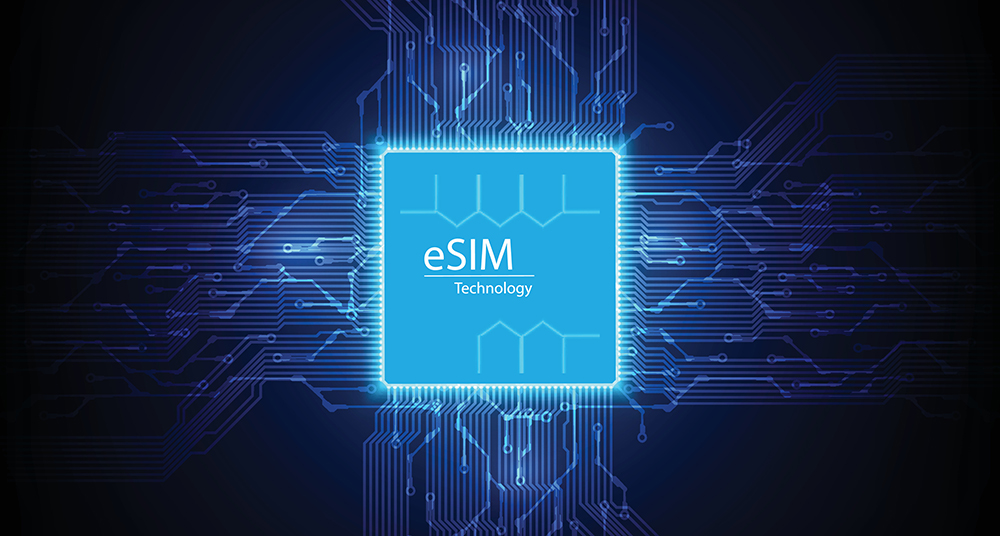
Business technology decisions are often based on three fundamental tenets – whether the technology creates revenue or reduces expenses, produces operational efficiencies and offers a high level of security. Any tech decision – including an IoT one – must be judged by these criteria.
One especially critical IoT decision concerns connectivity. Representing 5-10% of the value of IoT solutions, secure and reliable connectivity and data transfer is critical to the IoT ecosystem. If connectivity fails or is compromised, IoT applications fail.
Traditionally, IoT applications that rely on cellular networks for connectivity have used Subscriber Identity Module (SIM) cards. In recent years, however, the shortcomings of the traditional carrier SIM have led to a new standard for connectivity: The eSIM.
The concept of eSIM is simple. It digitizes SIM replacement. Instead of physically swapping out an actual piece of plastic to change the primary carrier network connection, the switch is done remotely without touching the device. eSIM technology brings choice and flexibility that, when looking at the three critical tenets of technology decision making, makes it the clear front runner of cellular IoT connectivity.
Future-proofed and maximized IoT investments.
Because SIM cards tend to lock users into a single carrier, a device user who wants to change network providers will need to purchase and install a new SIM. In contrast, eSIM gives an IoT device user the option to choose among a broader range of cellular networks and never needs replacement.
This is especially beneficial for devices deployed over a long period of time. Unlike simple roaming SIM cards, eSIM provides protection from evolving network technologies, such as the retirement of legacy services like 2G and 3G or the rise of new technologies like LPWA, as well as increasingly stringent government and carrier regulations and policies for IoT connectivity.
Another financial savings opportunity arises from the remote provisioning capabilities of eSIM. Because a single eSIM permits provisioning to multiple carrier profiles and easily switches to the most economical network available, it’s a cost effective solutions for data intensive applications.
Improved operational and logistical efficiencies.
When an IoT device leaves the factory with an eSIM, control of the SIM is handed to the device user rather than residing with the network provider. It also enables one SKU. The resulting control massively simplifies SIM management for the device user. With the capacity to administer all IoT subscriptions and connectivity in a single place, the complexity (and cost) of managing numerous carriers and dozens or even thousands of devices – even when spread across multiple geographies – is greatly streamlined.
Consider, for example, the need to track high-value construction or military equipment deployed across international borders or shipments of grain bound for consumers in several countries. When eSIMs are used for asset tracking, they automatically act like a local SIM and seek out the optimal carrier network. The same concept can be applied to global IoT device manufacturers that use a single SKU eSIM with all of their connected devices. Again, each device can be remotely and automatically provisioned to the appropriate local carrier profile.
The bottom line is this: The centralized management of inventory, contracts, platforms and invoices afforded by eSIM technology delivers significant operational and logistical efficiencies. This, in turn, gives device users the agility and scalability needed to support business growth. An eSIM’s out-of-the-box connectivity, capacity for global coverage and advanced auto-provisioning capabilities hands organizations the ability to expand current deployments or enter new markets quickly and easily.
Increased security.
The consequences of poor IoT security can be catastrophic for an organization. Risks include collection of inaccurate information, data overage costs, exposure of sensitive data, penalties due to security regulation non-compliance and damage to a business’ reputation. eSIM delivers an effective way to significantly increase data security.
Although eSIMs are available in various forms, including removable ones, many are meant to be permanently embedded into the device. This avoids the risk of that eSIM being lost or stolen. Moreover, by leveraging the eSIM as a Root of Trust to secure IoT applications, users establish chip-to-cloud security for IoT products and services as well as the ability to apply additional encryption to the data.
The rise of IoT connectivity powered by eSIM technology cannot be ignored. According to Counterpoint Research, shipments of eSIM-based devices will reach almost two billion units by 2025, up from 364 million in 2018, with enterprise IoT devices and activation rates leading the way. The reasons are clear: With highly secure eSIMs, organizations are able to minimize the total cost of ownership of connected devices and make impressive strides in efficiency in a way that’s simply not possible with a traditional single carrier SIM card. As more businesses look to IoT, they desire simplified, safe and cost effective ways to manage deployments. eSIM technology can provide exactly what they seek.
About the author: Marco Bijvelds, SVP EAP at KORE, brings more than 10 years of IoT experience through senior management positions. Adaptive to the dynamic and fast-paced IoT industry environment, Marco has been successfully implementing KORE’s go-to-market product strategy in Europe t, strengthen KORE’s position in the European marketplace.
Edited by
Ken Briodagh





